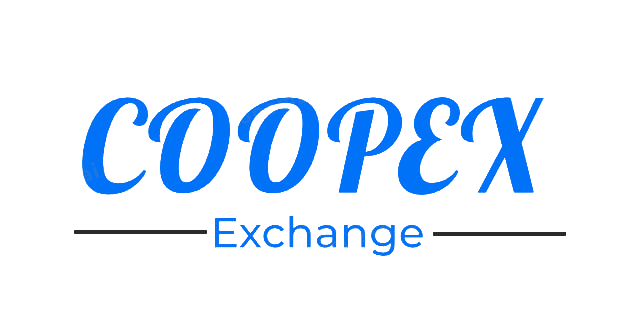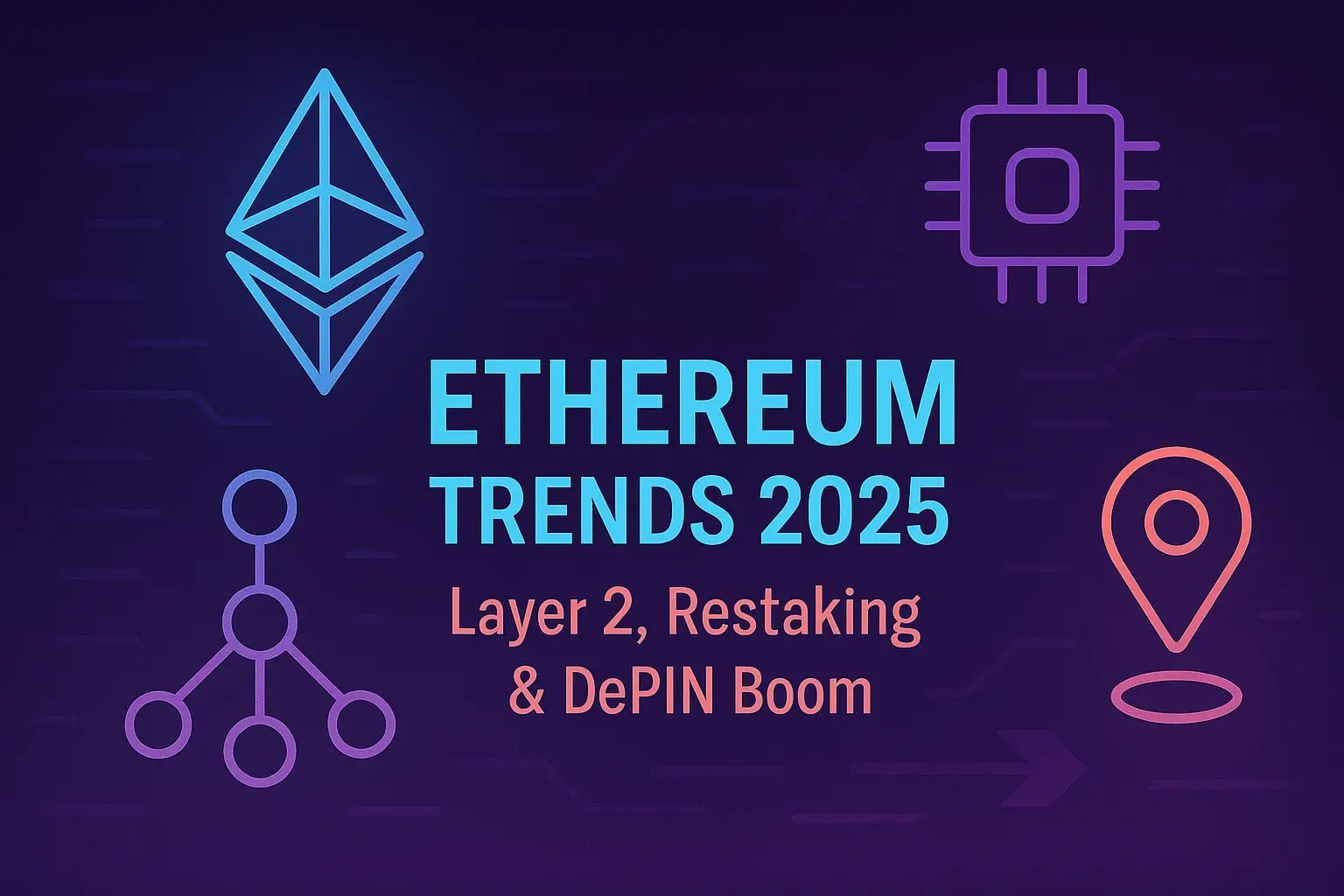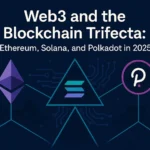Ethereum, the world’s largest smart contract platform, continues to set the pace in blockchain innovation. As of May 2025, the ecosystem is experiencing a surge in activity, fueled by advancements in Layer 2 scaling, restaking protocols, DePIN (Decentralized Physical Infrastructure Networks), and increased institutional involvement. Below, we break down the top Ethereum trends of this month and what they mean for the broader Web3 space.
Layer 2 Dominance Continues to Grow
Layer 2 solutions have become the backbone of Ethereum’s scalability in 2025. Networks like Arbitrum, Optimism, zkSync Era, Base, and Starknet now handle a significant portion of transaction volume and smart contract deployment.
What’s Driving Layer 2 Growth?
- Lower transaction fees: L2 networks offer near-zero gas fees compared to Ethereum mainnet.
- Faster transaction speeds: Most L2s confirm transactions within seconds.
- Enhanced developer incentives and grants: Platforms like Base and Optimism provide funding to L2-native projects.
- Strong support from Ethereum Foundation and Vitalik Buterin: Vitalik has consistently advocated for rollup-centric scaling.
- Modular architecture adoption: Developers are increasingly adopting modular frameworks that separate execution, settlement, and data availability.
Notable Metrics (Q2 2025):
| Layer 2 | TVL (USD) | Daily Tx Volume | Avg. Tx Fee |
| Arbitrum | $17.8B | 5.2M | $0.09 |
| Optimism | $12.4B | 4.1M | $0.07 |
| zkSync Era | $9.6B | 3.8M | $0.05 |
| Base | $7.1B | 2.9M | $0.03 |
| Starknet | $4.3B | 1.5M | $0.04 |
Layer 2 adoption is being further accelerated by mainstream applications integrating directly with L2s. For instance, decentralized social media apps like Farcaster and Lens Protocol have seen over 3 million new users since January 2025, largely due to smoother UX on rollups.
The Ethereum community is also exploring Layer 3 frameworks, enabling app-specific rollups. This approach allows developers to customize scalability, security, and performance based on specific dApp needs, reducing congestion on general-purpose L2s.
Restaking Becomes a Hot Narrative
Introduced via protocols like EigenLayer, restaking allows ETH holders to secure multiple services (oracles, bridges, rollups) using their staked ETH. This significantly boosts capital efficiency and introduces new yield opportunities.
Why It Matters:
- Enhances security of off-chain and on-chain protocols
- Provides ETH holders with additional yield from multiple services
- Establishes ETH as the “security layer” of Web3, beyond just Ethereum mainnet
“Restaking is turning Ethereum into a universal coordination layer,” says a16z researcher Lina Chao.
Top Restaking Use Cases:
- Securing bridges and minimizing cross-chain attack vectors
- Providing data integrity for oracle networks
- Bootstrapping new Layer 2 networks without relying on centralized sequencers
Several new protocols—including Symbiotic, Karak Network, and AltLayer—have entered the restaking ecosystem in Q2 2025, offering innovative staking derivatives and synthetic reward tokens.
Institutional players like Coinbase Cloud and Blockdaemon have begun supporting restaking infrastructure, citing strong demand from asset managers seeking diversified crypto yield strategies.
Rise of DePIN: Decentralizing Physical Infrastructure
Ethereum’s programmability is now powering real-world infrastructure. DePINs (Decentralized Physical Infrastructure Networks) are blending blockchain with IoT, energy, telecom, and AI-powered sensors to create open access infrastructure platforms.
Sectors Impacted by DePIN:
- Wireless connectivity (Helium)
- Cloud computing (Akash Network)
- Mobility data (DIMO)
- Energy grids (GridPlus)
- Sensor data for AI (Peaq, WeatherXM)
DePIN Metrics:
- Over 5 million physical nodes globally
- $1.4B+ in TVL across Ethereum and L2-based DePIN protocols
- Monthly growth rate exceeds 11% in active node deployment
“We’re witnessing a Web3-powered version of the Industrial Internet,” says DIMO co-founder Andy Chatham.
Governments and corporations are beginning to pilot DePIN-based infrastructure in rural and underserved areas, citing transparency and efficiency.
In April 2025, India’s Ministry of Technology announced a partnership with local DePIN networks to expand rural broadband. Similarly, EU smart city programs now include Ethereum-based DePIN for real-time environmental monitoring.
Ethereum’s Role in AI x Web3
In 2025, Ethereum is becoming a base layer for decentralized AI protocols. Projects like Gensyn, Bittensor, Fetch.ai, and Ocean Protocol use Ethereum to manage compute incentives, stake systems, and model marketplaces.
Examples:
- Gensyn: Pay-per-compute for distributed ML training
- Bittensor: AI model mining via stake-weighted incentives
- Ocean Protocol: Marketplace for AI models and datasets on Ethereum L2s
- Rejuve.AI: AI for healthcare longevity research, powered by DAOs
These protocols enable new business models like AI DAOs—autonomous agents that pay for compute, generate revenue, and reinvest into themselves.
Moreover, zero-knowledge cryptography is being used to protect data privacy in federated learning, enabling privacy-preserving AI use cases on Ethereum-compatible chains. This enhances trust in AI systems trained on sensitive data, such as medical records or biometric datasets.
ETH as a Core Financial Asset
ETH has evolved beyond being just gas for the network. In May 2025, ETH is widely used as:
- Collateral in DeFi lending protocols
- Restaking and dual staking asset
- Payment token in cross-chain ecosystems
- Yield-bearing synthetic (via Lido, Rocket Pool, Kelp DAO)
Over 37 million ETH is now staked—about 30.5% of circulating supply—representing a major leap in long-term holder confidence.
Top ETH utilities today:
- Minting stablecoins (RAI, crvUSD)
- Earning LSD yield (liquid staking derivatives)
- Participating in DAO governance
- Powering MEV marketplaces and block auctions
Additionally, Ethereum is being used as a settlement asset in institutional crypto markets. Platforms like Coinbase Prime and BitGo have integrated ETH as a base currency for OTC trades and custody services, signifying its increasing role as a crypto-native reserve asset.
Ethereum Protocol Upgrades: May 2025
Pectra EVM Upgrade Incoming
The Pectra upgrade is expected to be activated on mainnet in Q3 2025 and is already running on testnets. It includes:
- Improved calldata compression for cheaper transactions
- Reduced gas costs for storage write operations
- Native account abstraction to improve wallet UX
These features will help lower costs on rollups and enable smart wallet innovations like session keys, transaction sponsorship, and gasless onboarding for dApps.
The upgrade also includes improvements for MEV resistance and censorship protection, addressing growing concerns around validator dominance and transaction ordering.
Ethereum Outlook for Late 2025
Looking ahead, Ethereum is poised to:
- Launch Layer 2-specific governance models
- Integrate intent-based architecture to improve user experience
- Expand restaking into real-world assets (RWA) and CBDC security
- Host the first on-chain decentralized GPU marketplace via Gensyn
With rollups and restaking ecosystems becoming more composable, Ethereum is transitioning from a smart contract platform into a foundational layer for programmable economies.
Ethereum Trends Summary Table (May 2025)
| Trend | Description | Impact |
| Layer 2 Expansion | Scaling transaction throughput | Cheaper, faster apps |
| Restaking | Reusing ETH stake for more services | Boosts ETH utility and yield |
| DePIN | Infrastructure meets blockchain | Web3 powers real-world networks |
| AI x Ethereum | Blockchain for AI incentives and staking | Decentralized AI economy emerges |
| ETH Financialization | ETH as collateral, yield asset, payment tool | More capital efficiency in DeFi |
| Protocol Upgrades | New EVM features and account abstraction | Enhances UX and reduces gas costs |
FAQ: Ethereum in May 2025
What is the biggest trend in Ethereum this month?
Layer 2 scalability remains dominant, but restaking is quickly becoming a defining narrative for ETH holders.
Is Ethereum still relevant with new L1 blockchains?
Yes. Despite competition from Solana, Aptos, and modular blockchains, Ethereum’s rollup-centric roadmap and financial infrastructure keep it in a leading position.
What’s restaking and why is it important?
Restaking lets ETH be reused to secure multiple services, increasing its utility and opening new income streams for stakers.
How does Ethereum support real-world infrastructure?
Via DePIN protocols that build on Ethereum to offer telecom, cloud, mobility, and sensor-based services.
What’s new in the Ethereum protocol?
The Pectra upgrade introduces calldata and storage gas optimizations, plus native account abstraction to simplify UX and enable new dApp designs.
How will Ethereum evolve in the second half of 2025?
Expect deeper L2 integrations, emergence of AI-based DAOs, cross-chain restaking protocols, and more institutional ETH-backed financial products.

Herbert Vega is a blockchain and cryptocurrency expert with a passion for decentralized technology. He is the founder and CEO of XYZ Decentralized Exchange, a cutting-edge platform that allows users to trade cryptocurrencies in a secure and decentralized manner.




